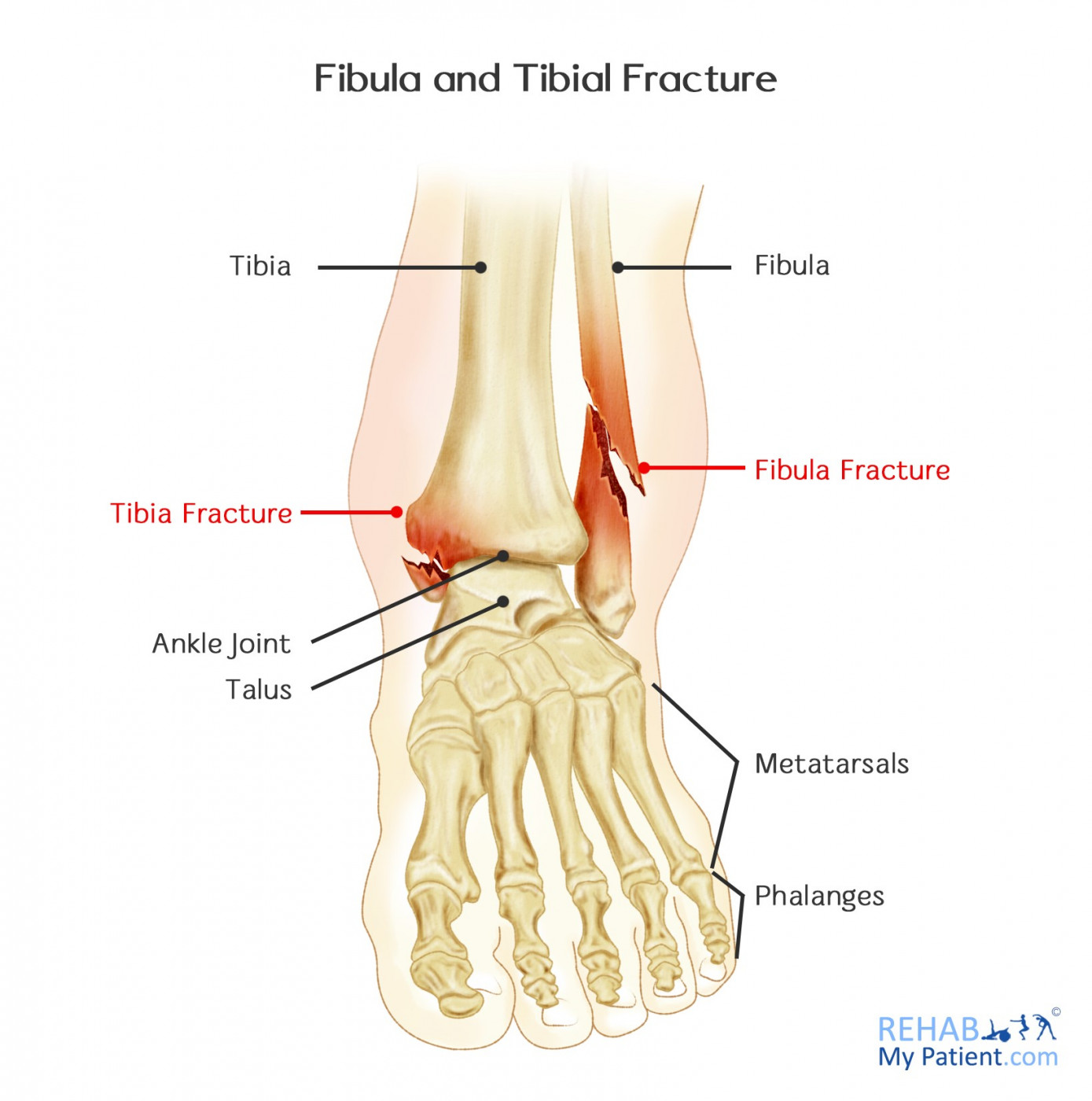

Early mobility with restricted weight bearing is encouraged. 27 Surgical treatment typically includes reduction followed by plate and screw fixation, intramedullary nail insertion, or external fixation. Nonsurgical management through the use of casts or braces may be provided for stable nondisplaced tibial and fibular fractures associated with low-energy trauma. Tibial shaft fractures can be classified based on their location (e.g., proximal, middle, and distal third) and through descriptive terms (e.g., simple, wedge, and complex) from the Orthopedic Trauma Association classification system.

Complications associated with tibial shaft fractures include anterior tibial artery and peroneal nerve injury and compartment syndrome. The higher the energy on impact, the more soft-tissue and bone damage occurs, including concomitant damage to the ankle (e.g., trimalleolar fracture, syndesmotic disruption, or talar dome fracture). Tibial shaft and fibula fractures typically result from high-energy trauma such as motor vehicle and skiing accidents. Elrod, in Acute Care Handbook for Physical Therapists (Fourth Edition), 2014 Tibial Shaft and Fibula Fractures. Various authors have suggested acceptable limits of 5 degrees to 10 degrees of varus, 4 degrees to 10 degrees of valgus, 5 degrees to 20 degrees of AP angulation, 5 degrees to 20 degrees of rotation, and 10 to 20 mm of shortening. The limits of acceptable deformity are controversial. įractures that cannot be maintained in “acceptable” alignment by casting or bracing.įractures with associated ipsilateral femur fractures or intraarticular fractures of the knee or ankle.Tibial shaft fractures with intact fibulae have a high risk of varus nonunion or malunion when treated closed. Reduction is difficult to maintain in spiral fractures of the tibia with similar factures of the fibula at another level. Significant instability is the fracture characteristic most apt to indicate the need for early operative intervention. Highly comminuted (= 50% of circumferential cortical continuity) or otherwise unstable fractures, such as those with greater than 2 to 3 cm shortening, greater than 50% translation, or segmental patterns. Open fractures require surgical treatment of the wound, and many will require continued access to the soft tissues, which might be obstructed by casts or braces. Ĭertain fractures can be predicted to do poorly without surgical treatment.Comparisons between IM nailing and cast immobilization (with some patients having screws or wiring before the cast) suggest a higher rate of nonunion, delayed union, decreased mobility, and more time off work with casting but a much higher rate of anterior knee pain with nailing. There has not been a direct comparison between functional brace treatment and IM nailing. In other words, the first radiograph shows the maximum deformity possible for the fracture if it is acceptable, the fracture can be treated without surgery. Īnalysis of radiographs reveals that the deformity seen on the original film does not increase over time with functional brace treatment.The relationship between tibial deformity and arthritis of the knee or ankle remains unclear. The amount of deformity that will be functionally significant is unknown and probably varies among patients with different expectations and activity levels. Although minor degrees of shortening and deformity are common with this treatment, they are of no functional significance. Malalignment is the most frequent complication of closed treatment. It facilitates quicker healing and return to function. This method encourages early motion of adjacent joints and earlier weight bearing. Sarmiento 3 have developed and advocated the concept of functional fracture bracing, in which the patient is placed in a premolded, somewhat pliable, removable fracture brace after about 4 weeks of casting. Rehabilitation required to address stiffness and weakness was often prolonged. Although tedious and inconvenient, this method resulted in a high rate of union and ultimate return to satisfactory function. Traditionally, nonoperative treatment consisted of immobilization of the limb in a long leg cast and protection from weight bearing from several weeks or months. Many if not most tibial shaft fractures can be treated successfully without surgery.


 0 kommentar(er)
0 kommentar(er)
